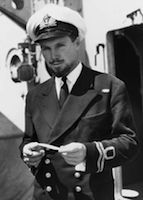Lieutenant Ian Desmond Rhodes

Ian Desmond Rhodes (Laurie-Rhodes) was born on 19 August 1912 at Ongaonga, near Waipawa, New Zealand, the younger son of Albert Victor Laurie-Rhodes, a sheep-farmer from Victoria, and his New Zealand-born wife Agnes, née McKay. In 1920 the family settled in Victoria and Ian was educated at Geelong Church of England Grammar School where he did well in sport, especially Australian Rules football. He turned to farming before working as a salesman. On 1 April 1939 at Christ Church, South Yarra, he married with Anglican rites June Phillips Allan, a dress designer, they were to have one child before being divorced on 7 November 1947.
Using the surname Rhodes, he attempted to enlist in the Army, Navy and Air Force on the outbreak of World War II, but was rejected because of a stomach ulcer. A sympathetic medical examiner cleared him for service on 17 September 1940 and he entered the Royal Australian Naval Volunteer Reserve as an Ordinary Seaman under the British Admiralty's yachtsmen scheme. Rhodes was immediately posted to Britain for further training at HMS Collingwood, before joining the destroyer HMS Kashmir on 1 April 1941 and the following month took part in the RN's attempt to prevent a German seaborne invasion of Crete.
On 23 May Kashmir came under enemy air attack while returning to Egypt to refuel. Hit amidships by a bomb, she broke in two and began to sink rapidly. When a German bomber machine-gunned both the stern section of the ship and members of her crew who were struggling in the water, Rhodes left the port Oerlikon gun (on which he was the gunlayer) as the water rose around it and climbed to the nearby starboard gun. Turning this weapon against the attacking aircraft, he shot it down in flames. Rhodes was rescued from the sea and taken to Alexandria in HMS Kipling, his only possessions a pair of shorts and a borrowed cap. He was awarded the Conspicuous Gallantry Medal (CGM) the highest decoration, after the Victoria Cross, which could be awarded to naval ratings.
Rhodes joined HMS King Alfred in late May 1941 for officer training and was promoted to Able Seaman in September of that year. He was commissioned as a Sub Lieutenant on 22 January 1942 and the following month was presented with his CGM by King George VI at Buckingham Palace. Joining the cruiser HMS Sheffield on 10 April 1942, he served in the Atlantic and Arctic oceans, escorting convoys to and from Russia. While serving in Sheffield he was promoted to Lieutenant and gained his Watchkeeping Certificate but his time onboard was far from happy with his Commanding Officer describing him as disappointing, slow to learn and unwilling to accept criticism.
In March 1943 he was transferred to the heavy cruiser HMAS Shropshire which was then being commissioned in England. He remained with that ship until July 1944, during which time the cruiser operated in New Guinea waters, with Rhodes winning favourable regard as a "keen and capable" officer and "well above average". Rhodes was posted ashore in July 1944 and served briefly at HMAS Lonsdale (Melbourne) and HMAS Cerberus (Crib Point) before sailing, in October 1944, to the United Kingdom. In late December he was appointed to HMS Mount Stewart, a naval special operations training base in Devon, England before joining the submarine depot ship HMS Maidstone in February 1945 as the 1st Lieutenant of the Services Reconnaissance Department Naval Section for service in the Pacific theatre. He was described by his Commanding Officer as "a sound, capable and dependable officer whom I consider to be outstanding".
Lieutenant Rhodes was appointed to Lonsdale, in December 1945, and demobilised on 26 April 1946, becoming a farmer at Labertouche, Victoria. On 27 November 1947 at the Collins Street Independent Church, Melbourne, he married with Congregational forms Patricia May Worboys, née Huxtable, a divorcee. He later went into business working for the United Linen Company Pty Ltd, importers and wholesalers of Irish manchester linen, and subsequently became a director of the company. Survived by his wife, and the son of his first marriage, he died of cirrhosis of the liver on 3 January 1967 in Fairfield Hospital and was cremated.



